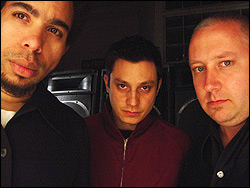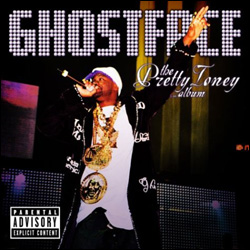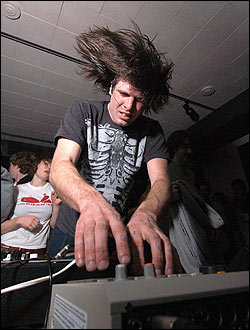THE ETERNALS
Rawar Style
(Aesthetics)
Rock may be dead, but zombies are way more tenacious than the living. Entertainment Weekly recently ran a feature on nu’s freshly tilled graves (Yeah Yeah Yeahs, Modest Mouse, the Killers, etc.), declaring, “Real alternative rock is back!” (Apparently “real” means power pop played with a distortion pedal by people who own a copy of Talking Heads 77.) While I appreciate the need for an alternative to Nickelback and Yellowcard, new wave is even less new 25 years later—earnest sludge or skinny ties, choose your cul-de-sac.
“A clapped-out stretch limo in reverse” is how journalist Simon Reynolds described modern rock in a 1994 article on what he called “post-rock.” For Reynolds, post-rock described British indie bands fired by 1988’s Year Zero-shoegaze, acid house, rap’s “golden age”-embracing all sorts of nonrock music in reaction to the retro-glam of early Britpop. In the U.S., it got applied to the jazzy math-rock of the Chicago school (Tortoise, etc.), vis-a-vis grunge. It seemed like the future at the time, but no one seriously uses the term 10 years later. Reynolds disowned it, the British bands were crushed by the Cool Britannia industry, 90 percent of the U.S. stuff was just King Crimson with vibraphones anyway, and, hey, maybe Suede and Pavement weren’t the Antichrist after all.
Still, the air of stalled possibilities that Reynolds heard those bands as a reaction to lingers, with rap, R&B, and dance almost as retro as rock right now. Human grit hasn’t been entirely outmoded, but most rock continues to hold itself back from the modernist precipice. There’s still the feeling that the best indie is the stuff that engages with technology and new sounds, not that’s scared stiff of them. (Holler at your Junior Boys.) Which is where “rock bands” embracing the present, looking to the future, and (even futurists can’t escape retro’s ensnarement) linking hands with past movements fired by similar concerns—post-punk, Krautrock, etc.—come in. So maybe they’re not so much post-rock as rock-plus.
Chicago’s Eternals began life as Trenchmouth around the time Tortoise laid the foundations for the Wicker Park dub sound. Rawar Style, their latest, is dance-rock kit built from early ’80s stuff like 2-tone, Return of the Giant Slits, Burundi drumming, pre-digital dancehall, and a patina of modern hip-hop know-how. Tortoise drummer John Herndon spasms out a biddly-biddly-bong dancehall riddim as vocalist Damon Locks chants/sings in a style somewhere between emo and Big Youth. It’s not always appealing, but any rap producer would be pleased to come up with the dusky “Silhouette,” which evokes DJ Quik and the RZA making the beast with two backs. Then real-time organ drones and Locks vocals creep over the loops, reminding us that the line between live and Memorex is uneasily defined here, and all the better for it.
SIXTOO
Chewing on Glass & Other Miracle Cures
(Ninja Tune)
Sixtoo likewise hits from a post-rap (woof) angle: He’s on Ninja Tune, he’s got fat beats, and he’s got no rhymes. DJ Premier might barely recognize the new Chewing on Glass as the same species of music as his, but the DNA doesn’t lie: loops + beats + turntable/sampler improvisations = hip-hop. You can imagine an MC riding the tense percussion and zinging orchestral stabs of the three-part “Boxcutter Emporium,” but it isn’t necessary. The one time Sixtoo does engage in a lyrical hookup, however, it’s with a post-rock O.G.: Damo Suzuki. The former frontman for Krautrock legends Can rolls out a string of classic mumbles, asides, and wordless nonsense on “Storm Clouds and Silver Linings” on a beat halfway between jungle and Tago Mago. As with Can, Sixtoo’s tracks groove, but they feel far closer to art-rock than funk, thanks to all the ambient dropouts, itchy textures, and smarty-pants time changes. Call it cut-and-paste psychedelia.
BARK PSYCHOSIS
Codename: Dustsucker
(Fire)
Reynolds coined “post-rock” in a Bark Psychosis review, so it’s fitting that the band that prompted it all is back with only its second album in a nearly 20-year existence, which takes off where the slow, careful fanfares of late period Talk Talk petered out. (Mogwai would be unthinkable without BP’s early singles.) Sole remaining member Graham Sutton returns after a long detour in drum and bass with the new Codename: Dustsucker. Tracks like “INQB8TR” and “Miss Abuse” are closest to the BP of old, all dolorous texture sweeps and moody cloud fronts. (“Miss Abuse” ends with Roland 303 acid squiggles more doom metal than pleasure principle.) “From What Is Said to When It’s Read” climaxes with a terrifying “solo,” blocks of liquid granite guitar like an earthquake buckling the pavement. Sutton is not a writer of songs, but for alien textures and mood cultivation he’s second to none, a Hassell or Eno for the 21st century. He may not be as pretty as Karen O or have a “Maps” in him, but if the two ever hook up in Berlin, look out.
Sixtoo plays Chop Suey with Blockhead and DJ Signify at 8 p.m. Tues., Sept. 7. $10 adv.








